Personal Branding: Viewing the world
May 22, 2013 1 Comment
The last six days have been incredibly busy. I tried three times to put up a quick blog post but each time, the word count got away from me. I have resolved to do several additional things on this blog.
- I have turned on the passive voice grammar checker in word. I will endeavor to eliminate as many passive form statements as I can.
- I will break up some of these long-winded posts into more consumable chunks. At the end of a series, I will use a summary post to bring it together without a seven or eight page commitment.
- My summary statements will be at the top of the post. This is a form of writing called, by at least one blogger, inverse pyramid. It imparts knowledge without the creation process or assumptions getting in the way. My assumptions and process will still be in the post, but further down. It allows for a quick read and filter of the knowledge. I am going to accomplish this by writing the post and then summarizing the points at the top.
There is another five pages easily here so I am going to split this up into at least a two parter. As always, any feedback is certainly welcome.
Human beings are unable to consume the vast amount of what occurs around us. In response to this deficiency, our brains have developed a deep understanding of what is and is not important in many situations. This understanding is our ‘View’. The ‘View’ has a hierarchical nature. It flows down from the most abstract concept of ‘Me’, to our primary roles in life, then down to individual activities we partake in. ‘Views’ change and adapt as our skill level changes. The more skilled we are in something, the less minutia our brain processes.
‘Views’ relate our experiences and expectation. Our views are described by our skill in that particular view.
When the skill level is low, the ‘complexity of view’ or ‘maturity of view’ is low. This results in:
- Lots of information handed to brain for processing.
- Easy to incorporate new information into the view.
- Easy to incorporate wrong information into the view.
- At this level of skill, the view is ‘High Maintenance’.
- I use ‘High maintenance’ because the view requires greater amount of energy as it is constantly changing and adapting to new information.
- I use ‘High maintenance’ because it is easy for faulty information to get incorporated into this view.
- Hard to sink into selection and confirmation biases at this level. The view is not yet mature enough to seek confirmation or select agreeable points intentionally.
When the skill level is high, the ‘complexity of view’ or ‘maturity of view’ is also high. This results in:
- Inputs easily filtered. You know what you are expecting.
- ‘Low maintenance’ as little energy is required to maintain views at this level.
- Incorrect data is less likely to be entered as valid because of your ability to correlate at this level.
- Very difficult to change this view. You have seen it a thousand time.
- Easy to sink into confirmation and selection biases at this level.
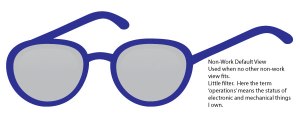
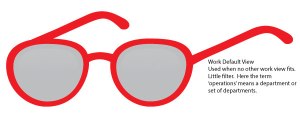
This is why driving is such a forgetful experience. We are so skilled at driving that we rarely remember what happens on our drive unless something contradicts our accepted ‘View’. When we are poorly skilled at something, our ‘Views’ do not know what is important and therefore feed us all data.
The top-level view is a view that contains little more than the basis for our personality. Our sense of fairness, tolerance to cause pain, etc. all exist inside of the default top-level view. For example, when I rode a horse for the first time, this default top-level ‘View’ knew not to randomly hurt the horse. This view did not know how to make the horse go up the hill without stopping for food. My memories of this experience, even though they are 6 months old, still are seared into my brain. However, the last 15 times I walked to work, not much of anything in memory, and it happened over the course of the last 3 weeks.
This is my ‘View’ of my ‘Views’.
- Micah Default View (Skill level 0) – Many aggregations, lots of excess data to interpret, lots of data loss due to misunderstanding, poor interpretation and data loss events due to aggregation and abstraction. This is the view assumed when entering an unknown situation. This is the basis or ‘root’ of all other views.
- Micah Work Views – This is the basis or ‘root’ of all other work views.
- Micah at work creating policies (Skill level 5) – Somewhat competent. Small amounts of excess data processed. I know what is and is not important. Easily incorporate unexpected information into model.
- Micah at work deploying exchange server (Skill level 10) – Extremely competent. Little to no excess data processed. Expectations rarely deviate from reality. Difficulty incorporating new information into model.
- Micah Work Views – This is the basis or ‘root’ of all other work views.
- Micah Non-Work Views – This is the basis or ‘root’ of all other non-work views.
- Micah Illustrating (Skill level 2) – Just learning. Many excess data to interpret. Competing instructions without ability to filter. Very easy to incorporate new information into model. Very easy to incorporate wrong information into model. Continuously analyze model to define best practices.
You will note that the pictures of the more developed views have darker lenses. I believe this is true because they filter a greater amount of the junk out. The view controls what we find important in any situation. It controls the data that our brain inputs for processing, how it processes that data, and what to do with the results. This process is important to understand for many reasons.
- Why we notice certain things and not others. Are some of those things we are not noticing important?
- How we develop and master new skills.
- ‘Views’ can be used to ensure that we are living up to our vision of ourselves. Each view is a step down the chain from our strategic selves all the way to our operational actions. To utilize this, first we must understand our views.
- Highly developed ‘Views’ can make us unresponsive to change. We all know someone who refuses to do X+1 because they are amazing at X. It brings to mind people who refuse to embrace digital photography because they are amazing in the dark room.
You are late for work again. The stupid light at Lakeshore and Belmont just went yellow. It is going to cost you 5 minutes to wait for this light. So you do what I would do and punch the gas. You get through the light and off to work you go. But what happened after you left?
Hitting the gas caused your car to convert additional chemical energy into kinetic energy. The road absorbed some of that energy as heat and movement. That transfer caused a slight vibration. That vibration knocked a leaf loose from a nearby tree. That leaf fell into a pedestrian’s eye. The pedestrian paused for 3 seconds to clear the leaf before moving on with his commute. He was not in the crosswalk when a distracted drive blew the light thus narrowly missing being killed. I assume we all recognize the ‘Butterfly effect’ at play.
Let us go even further. 1.4 billion years ago, the sun fused four hydrogen atoms into one helium atom. That process released a little packet of energy called a photon. That photon spent a billion years working its way out from the center of the sun to the surface.* It then spent 8 minutes traversing the distance from sun to the earth. It bounced around the atmosphere being absorbed and reemitted. Eventually, a newly formed fern in a Paleozoic swamp absorbed it. ** That fern used this energy through photosynthesis to create material for its growth. Eventually the fern dropped the leaf, which absorbed the photon to the bottom of the swamp. 400 million years of compression and chemical change later, a drill from a BP Oil derrick brings a gallon of oil to the surface, which contains some of the atoms, which were in that leaf. Three months later, you pump the gas resulting from this oil into your car. The spark plug triggers an explosive expansion event in a piston because you punched the gas to get through a light at Lakeshore and Belmont…
All around us, every second of every day, an untold number of reactions and interactions are occurring. The vast majority of these specific events are below our notice. We cannot possibly watch all of this. Wind blowing, trees swaying, water moving is all nothing more than a transition of energy state and input/output system. Do not quote me on this, because I have lost the source (I believe the source was an NPR podcast episode on multitasking), I heard that the average human male’s brain has the capacity to process 3 related bits of data at a time. The average human Female outstrips us simple males by being able to process 7 related bits of data at a time.*** That is 3 and 7 individual datum’s at a time. That is appallingly low. Since we cannot consume all of these interactions, nature has provided our brain with an automatic modeling, abstraction and aggregation capacity. These are our ‘Views’.
This controls more than how we see the world. It colors all of our interactions. Language and pattern recognition. Love, hate and everything in between are derived from these views. Nothing is outside of their purview.****
Even though the IPO (Input, Processing, and Output) diagram has lost some favor in the business community, I still like it for analysis purposes. So let me use an IPO diagram to give my perspective of ‘Views’.
This is the basic IPO chart. It has an input item, a processing item and an output item. Interpret these terms as broadly as possible.
To my point, imagine the input item saying, “A round hard object nearly a foot in circumference is moving towards me at 40 to 90 feet per second.” What does processing do here? Without a view to apply this to, we have no idea what models or aggregates to apply and our output requires processing to function. So in essence, the processing portion of the IPO chart looks to the ‘View’ for a definition of appropriate abstraction models and aggregations. So let us do a couple. (Because I see views as the way we perceive the world, I drew a set of sunglasses to help illustrate my point. I am in the process of learning to Illustrate and cartoon so please be understanding for the next few weeks. The quality will increase over time.)
The overall point in these images is that the exact same input can result in completely different output based on the Model Lookup, which the view provides to the processing function. I am going to add one piece to the basic IPO Chart.
*Not sure if this number is right. I think I heard this somewhere but regardless it takes an enormous amount of time to get out of the sun to the earth.
** Some of these ages may be inaccurate. 400 million years ago was the Paleozoic era, and I believe ferns were around back then, but I have not sited any sources for this. The exactness is not important for the point. Just think long ass time!
*** As I said, I have lost the source and do not want to delay this post trying to track it down. The point is not the exact number, which is certainly debatable, but that our ability to process is severely limited, which is not debatable.
**** I have heard that some cytotropic drugs limit the ability of the brain to filter. I have no idea if this is true or not. I have not researched this at all. Purely hearsay and anecdotal. Statement not to be derived as evidence.
Micah Norman
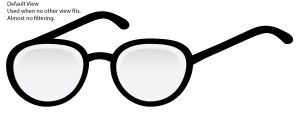
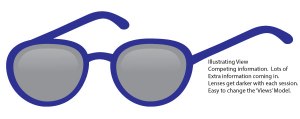
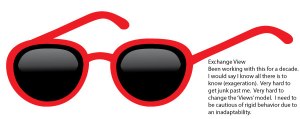
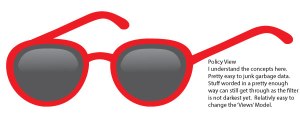

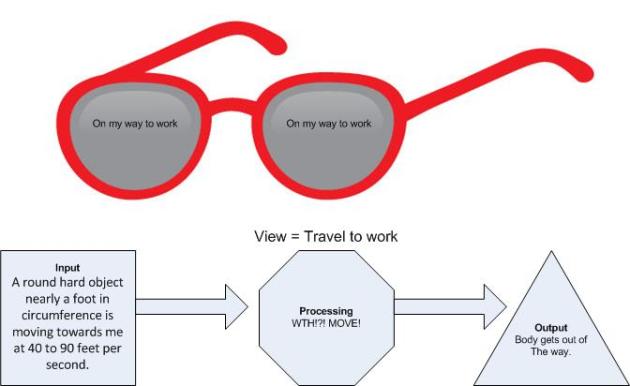
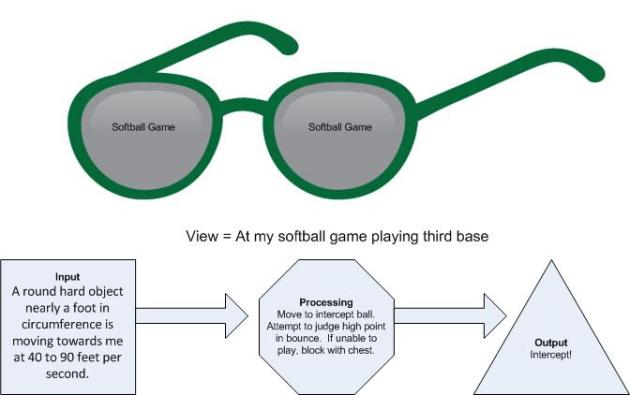
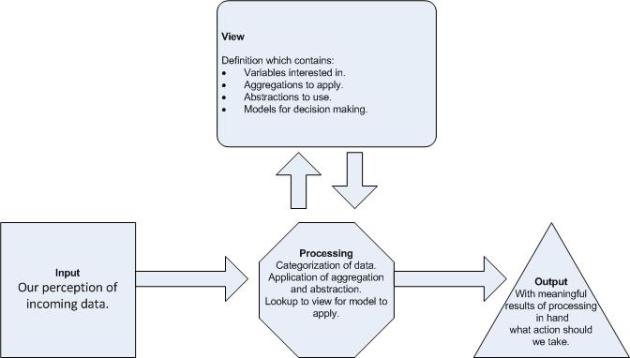

Recent Comments